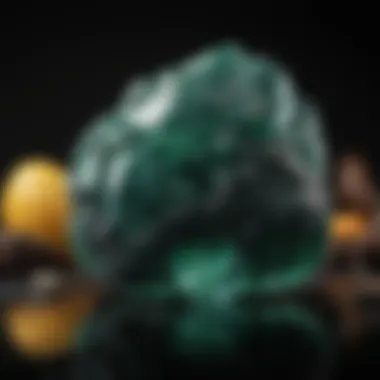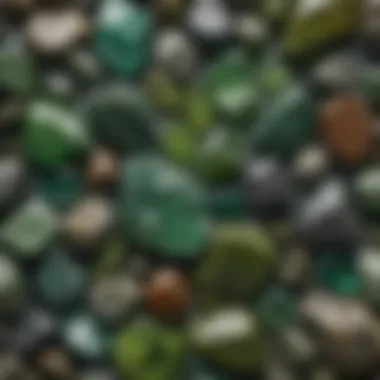Exploring Green Rocks and Minerals: A Detailed Guide


Intro
Green rocks and minerals offer a unique perspective for enthusiasts of geology and mineral collecting. Their vibrant colors often grab attention, yet their formation and characteristics are even more fascinating. Understanding these rocks and minerals can enable both novice and experienced collectors to better appreciate what they encounter in their pursuits.
Rock and Fossil Identification
Identifying rock and fossil specimens correctly is fundamental to any collection. This step not only enriches the collector's knowledge but also enhances the integrity of the collection itself.
Types of Rocks and Fossils
Green minerals can occur in different rock types including igneous, sedimentary, and metamorphic. Notable examples are:
- Serpentine: Often found alongside ultramafic rocks, it is characterized by its green color and often a greasy feel.
- Diopside: Common in metamorphic rocks, this mineral may also present in intriguing green hues, especially the chrome diopside variety.
- Malachite: A copper carbonate that brings striking green banding to a collection, frequently found alongside azurite.
Characteristics to Look For
When evaluating green rocks and minerals, pay attention to:
- Color Variation: Different shades of green can indicate specific mineral compositions.
- Texture: Some minerals has a smooth feel, while others are rough or fibrous.
- Hardness: Utilizing the Mohs hardness scale can assist in determining a mineral's durability.
- Luster: The surface quality—whether glassy, dull, or metallic—plays a role in identification.
Tools for Identification
Here are some basic tools every collector should consider:
- Hand Lens: A simple 10x hand lens allows close inspection of crystal structure and surface texture.
- Field Guide: Having a resource specific to local geology goes a long way in proper identification.
- Testing Kit: Essential chemical tests such as fizz tests can differentiate between similar-looking minerals.
Proper identification serves as the foundation for an effective collection.
Collecting Tips and Techniques
Best practices benefit both new and seasoned collectors as they aim to build their collections responsibly and ethically.
Best Practices for Collecting
- Respect natural habitats by limiting disruption to the environment.
- Avoid privileged sites and public lands unless explicitly permitted.
- Only collect responsibly, leaving ample material for other enthusiasts.
Locating Prime Collecting Sites
- Local Parks: Many parks offer geological diversity, with a variety of outcrops available for exploration.
- Quarries and Mines: Often, older quarries feature mineral specimens. Securing permission from landowners is key.
- Collectors Clubs: Engaging with club members can reveal prime spots through shared knowledge.
How to Safely Extract Specimens
- Use appropriate tools such as chisels and hammers safely.
- Wear safety gear to protect from potential hazards.
- Prioritize intuition; if it feels unsafe, reconsider the approach to extraction.
Preservation and Display
Caring for and displaying collections ensures long-term enjoyment and appreciation.
Techniques for Preserving Rocks and Fossils
- Store rocks in a cool, dry environment to minimize deterioration.
- For more delicate specimens, consider using silica gel to manage moisture levels.
Proper Storage Methods
- Display Cases: UV protection can prevent fading; aim for breathable containers.
- Labels: Keep identification secure, attaching notes detailing the mineral origin and where it was found.
Creative Display Ideas
- Group by color, size, or mineral type for impactful presentation.
- Using high-quality lighting highlights the aesthetic features of each specimen.
Geological Insights
Gaining insights into geology provides depth to the appreciation of rocky treasures.
Geological Formations and Processes
Understanding how specific formations came about leads to curiosity about environmental evolution. Consider the processes of volcanic activity, metamorphism, or sediment deposition.


Historical Significance of Rocks and Fossils
Many deep-rooted relationships exist between societies and geology, including mining efforts in specific areas. Sustainability debates also stem from such historical identifiers.
Notable Discoveries in the Field
Emerging discoveries continually shape rock and mineral documentation, impacting both scientific inquiry and collectors’ ambitions. Following publications from geological societies can furthering grasp on what is available.
In summary, melding scientific insight into education ultimately deepens the appreciation of green rocks and minerals, steering an enriching journey into the world of geology and collections.
Prelude to Green Rocks and Minerals
The significance of green rocks and minerals extends beyond mere aesthetic appeal. These geological specimens have unique characteristics, cultural implications, and essential roles in understanding Earth’s processes. Collectors and enthusiasts often seek out these specimens not just for their beauty, but also for their scientific and historical value. Understanding green minerals opens up pathways to discussions about geology, ecology, and alternative practices in collecting that enhance responsibility and consciousness towards nature.
Defining Green Rocks and Minerals
Green rocks and minerals are a diverse category distinguished primarily by their green coloration. This color comes from various elements and compounds that influence their formation. Common examples of green minerals include; jade, serpentine, and chlorite. Each has unique physical properties and chemical signatures quantified through specialized tests. Based on factors like transparency, hardness, and luster, enthusiasts can identify and catalogue these specimens with greater accuracy. Often, the allure of these minerals lies in their rarity and complex histories formed through geological processes such as metamorhpic and sedimentary actions.
Historical Context of Green Minerals
The history of green minerals provides insights into human culture’s interaction with the earth. Green minerals have been used for millennia in tools, ornaments, and as trade goods. For example, jade held a prominent place in Mesoamerican culture, where it symbolized wealth and power. In historical contexts, green minerals have more than utilitarian value; they often carried social significances, seen prominently in artifacts from different civilizations, illustrating the human connection to nature and its resources through art. Their usage spans across ancient cultures in the form of amulets, burial goods, and ceremonial objects, emphasizing not just their material but also symbolic heritage. This offers a deeper appreciation of green rocks as part of our global narrative.
Geological Formation of Green Minerals
Understanding the geological formation of green minerals is vital to comprehend their properties and significance. These minerals are not just aesthetically pleasing but also hold clues about Earth's processes. The examination of how green minerals form reveals essential information about the elemental composition and environmental conditions under which they develop. This aspect influences their distribution, use, and prominence in both industrial applications and in collections.
Influence of Chemical Elements
Chemical elements play a critical role in defining the characteristics of green minerals. Minerals like chrome diopside and malachite acquire their movement toward the green spectrum primarily due to specific elements. For instance, chromium adds a vibrant green tone to diopside, making it highly sought after. Similarly, copper gives malachite segmental patterns and its characteristic deep green color.
Also, a unique aspect of mineral formation is the isotopes present in various chemical environments. Are the minerals formed under oxidized or reduced conditions? This question dictates the trace elements present, altering properties. In summary, understanding these chemical contributors aids rock hounds and mineralogists alike in their efforts to identify, classify, and appreciate these rare specimens.
Role of Environmental Conditions
The environment where green minerals form influences their final characteristics profoundly. Factors such as temperature, pressure, and the surrounding medium's chemistry dictate the crystal structure and formation classification. For example, high-pressure environments often create dense packing in minerals like serpentine, impacting their hardness and density levels.
Moreover, pH levels in the surrounding fluid during deposit formation will favor certain minerals over others. These variations can be critical to identifying potential mining regions, ultimately aiding enthusiasts and professionals in locating desired specimens.
Green minerals manifest under a broad range of conditions, from metamorphic processes to hydrothermal systems that allow diverse formations.
Understanding the geological backdrop for the formation of green minerals provides essential insights for collectors regarding not only the specimen itself but also its history and value.
Additional investigation into the environmental contexts of these minerals may lead to revelations about broader geological processes affecting Earth's ecology and ores.
Common Types of Green Rocks and Minerals
The variety of green rocks and minerals presents both enthusiasts and scholars a rich avenue for study. These natural formations not only add beauty to collections but also hold geological significance. Understanding the different types is crucial for identifying the properties and uses these minerals offer. Discussions of green jade, serpentine, and chlorite will highlight their individual characteristics, relevance, and applications.
Green Jade
Green jade is often revered as a gemstone, associated with spiritual and healing qualities. Its toughness makes it ideal for various forms of craftsmanship, leading to its popularity in jewelry and artifacts. Jadeite and nephrite are the two types of jade, differing mainly in their mineral composition.
- Jadeite is rarer and generally valued higher than nephrite. The vivid green coloration in jadeite comes from the presence of chromium.
- Nephrite has a more muted appearance, reflecting its general mineral content such as iron and calcium.
Jade's value extends beyond aesthetics; it has cultural significance in many traditions, particularly in Chinese culture. Here, jade represents purity and moral integrity. For collectors, understanding jade varieties is vital for assessing authenticity.
Serpentine
Serpentine minerals, characterized by their green coloration, are fascinating for both collectors and geologists. These minerals often exhibit a variety of shades due to the presence of iron and magnesium. On a practical level, serpentine is not just decorative; it serves as a source of asbestos, a significant industrial mineral. However, its use raises environmental concerns due to the dangers of asbestos exposure.
Two related groups of serpentine minerals are:
- Lizardite, often found in fibrous morphologies, emphasizing its layer structure.
- Chrysotile, commonly used in industrial applications due to its fibrous characteristics.
For rock collectors, recognizing serpentine involves noting these key identification techniques, helping to determine its source and potential applications.
Chlorite


Chlorite showcases a rich tapestry of hues but is distinct with its darker green tones. This mineral group primarily composes silicates and offers crucial insights into metamorphic rock transformations. Its layered structure enables water retention, contributing ecologically to its environment.
- Geological Indicators: Presence of chlorite can signify specific pressures and temperatures during rock formation.
- Environmental Roles: It aids in soil fertility by maintaining suitable moisture levels.
For mineral collectors, identifying chlorite and determining its location can help reveal much about geological processes in various regions. Understanding the nature of chlorite adds depth to the collection itself, prized by those interested in metamorphic geology.
"Understanding the properties and origins of each green mineral enhances appreciation not only for their beauty but also their geological significance."
Identification Techniques for Green Minerals
Identifying green minerals correctly is crucial for both enthusiasts and collectors. Accurate identification allows for a deeper understanding of a mineral's unique characteristics and aids in its classification. With a myriad of green minerals, clarity in identification enhances the collecting experience and can lead to increased appreciation for these assets. The methods discussed in this section—visual characteristics, hardness tests, and chemical composition analysis—are significant techniques that every collector should be familiar with.
Visual Characteristics
The visual characteristics of green minerals are often the first indicators that aid in their identification. Color, hue, and translucency can vary widely among different minerals. Factors such as surface texture and luster also come into play. For example, green jade typically exhibits a smooth, polished surface with a vibrant and transparent shade of green. On the other hand, serpentine presents a more fibrous texture with a distinct silky appearance.
Enthusiasts should be observant of the following traits:
- Shade of green: Ranging from pale green to deep green tones.
- Transparency: Whether the mineral is opaque, translucent, or transparent.
- Surface texture: Rough, smooth, or crystalline structures.
- Luster type: Glossy, dull, or vitreous shine.
Collecting photo evidence of these characteristics for reference may also prove valuable when differentiating similar minerals in the field.
Using Hardness Tests
Conducting hardness tests on minerals is another effective technique for identification. This method leverages Mohs hardness scale, which ranks minerals based on their relative hardness. Understanding where your mineral falls on this scale will help differentiate between certain types. For example, green jade typically ranks between 6 and 7 on the scale, while chlorite is lower, often rated at around 2 to 4.
Here is a simple approach to conducting a hardness test:
- Gather common items to test it against, for example, a knife blade, glass, or a fingernail.
- Check if your mineral can scratch the item or is scratched by it.
- Measure the relative hardness using the scale established by Mohs.
This practical technique allows for unambiguous differentiation among minerals possessing notable similarities in color.
Chemical Composition Analysis
Performing a chemical composition analysis provides the most precise outcomes in mineral identification. These analyses assess the elemental makeup of minerals, offering insights that are not visible to the naked eye. Instruments like scanning electron microscopes or X-ray fluorescence devices can unveil the specific elements present in a mineral sample.
Not only can this technique confirm a green mineral's identity with a high degree of accuracy, but it also informs the collector of the possible source and geological history. Understanding the mineral's chemical formula will lead enthusiasts toward deeper geological knowledge, impacting their collection.
Rarity and Value of Green Rocks
The rarity and value of green rocks and minerals play a significant role in the world of collectors, enhancing their desirability and pricing.Collectors assess the quality and uniqueness of these specimens. With specific geological features and the practical applications mattering, understanding the rarity can help enthusiasts identify tightly held investments.
Factors Influencing Rarity
Several elements influence how rare a green rock or mineral is. Here are some critical factors:
- Geological Availability: The original formation and where these minerals are found is essential. Some minerals only appear in limited locations, increasing their rarity.
- Market Demand: Places such as jewelry or industry drive the need for certain stones. A surge in collectors may increase the excitement around a particular mineral, boosting its status.
- Condition and Quality: The state of the mineral significantly affects its value. That includes overall appearance, lack of blemishes, and crystal formation.
- Historical Context: Many minerals come with a backstory or context that increases their significance. This history can improve value, especially if the piece is linked to renowned collectors or events.
Understanding these factors aids in determining the commercial potential and prestige within a collector's collection.
Market Trends in Collecting
Keeping an eye on market trends reveals how interest fluctuates regarding specific green minerals. Here’s what you must know:
- Increased Interest in Sustainability: Many collectors are now drawn to minerals that represent natural beauty and earth conservation. For example, jade and emerald might see a popularity rise given the culture of valuing natural and ethically sourced items.
- Celebrity Influence: Just as with fashion, minerals can gain attention from celebrities showcasing stunning pieces. This drives others to search for similar items, can inflate their market value rather quickly.
- Online Marketplaces: Platforms like eBay and dedicated geology forums make buying and selling minerals more accessible. More sellers lead to increased competition, affecting price dynamics.
- Collecting Communities: Groups on platforms such as Reddit or Facebook always discuss which rocks are coming into vogue. Knowledgeable collectors share insights, influencing market buzz.
Whether one studies these trends to enhance collections or seller avenues, it is essential for both buyers and enthusiasts.
Keeping informed about market behaviors is as useful for buyers as it is for sellers. Rarity blends seamlessly with trends influencing prices without hesitation.
Understanding these facets shed light on the mutual relationship between rarity and everything linked to its perceived value.
Applications of Green Minerals
The iconic green minerals and rocks extend beyond aesthetic appeal. They serve key roles in various fields, making them of interest to industries and cultures alike. Understanding these applications adds depth to anyone's appreciation of green minerals, be it collectors or geologists. The two primary domains of application are their industrial uses and cultural significance.
Industrial Uses


Green minerals, such as jade and serpentine, have significant application in industries. These uses highlight their physical and chemical properties, making them essential for special purposes.
- Construction Materials: Serpentine is often used as a dimension stone. Its natural resilience and aesthetics make it valuable in building projects like wall facades.
- Manufacturing Items: Various green minerals are integral in manufacturing, especially in creating jewelry and ornaments. Green jade, for example, is particularly sought after in fine jewelry due to its beauty and durability.
- Technological Applications: Many green minerals are utilized in cutting-edge technology. For instance, chlorite has been studied for its potential uses in ceramics and even battery technology.
Green minerals also play a role in environmental applications. Their presence can indicate certain geological formations, which might help in resource location, such as in mining efforts.
Cultural Significance
Green minerals carry deep cultural meanings across different societies. Their use goes beyond mere functionality and often entails heritage and symbolism.
- Historical Relevance: Many cultures have revered stones like jade for centuries. In Chinese tradition, jade symbolizes purity, nobility, and moral integrity. Its procurement and crafting into art pieces represent skill and culturally significant practices.
- Spiritual Beliefs: In various societies, green stones are considered powerful spiritual symbols. They are often included in rituals or crafts associated with good fortune and protection, showing their significance in relationship to human beliefs.
- Artistic Expression: Throughout history, green minerals have inspired artisans. The unique colors and forms have contributed to stunning artworks and artifacts, transcending their natural form into objects of spirituality and identity.
In summary, green minerals are not just geological wonders; they hold practical value in industries and deep cultural roots in human societies.
Green Rocks in Environmental Studies
The study of green rocks in the context of environmental studies offers an insightful look into the Earth's processes. Green minerals often play a crucial role in understanding geological transformations and the accompanying effects on ecosystems. By examining these specimens, researchers can gain a better grasp of how mineralogical changes impact the surrounding environment. This section highlights essential elements regarding the significance of green minerals in environmental research.
Indicators of Geological Activity
Green rocks can serve as important signs of geological activity. Their unique mineral compositions often reflect the conditions under which they formed. For instance, the presence of specific minerals like chlorite may indicate past volcanic activity or major tectonic events. Notably, geologists often analyze these formations to understand better their history.
- Hydrothermal Fluids: Green minerals may also arise from hydrothermal activity. Their formation often provides evidence about the temperature and composition of fluids circulating through the subsurface.
- Plate Tectonics: Recording shifts in mineralogy can reveal events like plate movements. This information is essential in understanding the larger implications for natural disasters and mountain formation.
Overall, green minerals act as a window into past geological activity.
Impact on Biodiversity
The relationship between green rocks and biodiversity showcases their influence on environmental conditions. This connection is pivotal as it exemplifies how geology and ecology intersect. Various amino acids and elements from green minerals enrich soil and waterways, fostering plant growth and aquatic life.
- Nutrient Cycling: Green rocks often contain essential nutrients vital for plant life. Their presence can improve soil quality, supporting more diverse flora.
- Habitat Creation: Minerals like serpentine can create uniquely found microhabitats. The specific conditions offered by these minerals can support organism types that might not thrive in standard environments.
A decline in crucial mineral sources could disrupt local ecosystems. Thus, ongoing research into the effects of geologically significant rocks on biodiversity remains a pressing concern.
Understanding how green minerals influence our ecosystems is not merely an academic pursuit. It is essential in conserving biodiversity and mitigating the impacts of environmental change.
Collecting Green Rocks Responsibly
Responsible collection of green rocks and minerals is not differentiable merely as a hobby. It represents a commitment to maintaining the integrity of natural landscapes and honoring the heritage embedded in these geological treasures. For many collectors, understanding the implications of their collecting practices is vital. This ensures that future generations are afforded the same awe and appreciation for these remarkable specimens.
Ethical Considerations
Collecting minerals carries a weight of moral responsibility. When enthusiasts take specimens from the wild, it can lead to damage of habitats and ecosystems. Therefore, it is crucial to consider the impact of one’s activities. Respect for the environment includes understanding which areas are sensitive. Hunters of minerals should focus on sustainable practices to ensure that they do not contribute to negative outcomes.
- Promoting awareness on preserving flora and fauna.
- Engaging in community dialogues on conservation objectives.
- Advocating for policies which protect local geology.
In instances where a collection may strip minerals from their contextual beds, one risks losing vital information on geological history. Ethically sourced specimens retain more than just physical attributes; they carry stories of formation and the processes involved. Engaging in local conservation efforts, such as participating in clean-up days or supporting parks, ultimately extends the reach of responsible collecting.
Regulations and Permits
Understanding legal frameworks governing mineral collection is a major assert in responsible collecting. Many regions impose specific guidelines that dictate when and how collectors can access mineral-rich areas. Regulations may safeguard rare specimens and prohibit mining techniques that scale back entire environments.
- Know Local Laws: Familiarity with the regulations relevant to specific locales is non-negotiable.
- Seek Permits: In several places, acquiring a permit is mandatory for obtaining specific types of minerals. This process is often seen as an opportunity to reinforce ethical collection.
- Volunteer for Permits: Some local geological societies often issue permits expressly for educational purposes or scientific pursuits.
Being conversant with legislation allows collectors to unfold the rich knowledge inherent in green rocks while practicing responsible distaste. It bolsters respectful engagement with communities involved in preservation and protection.
“When collecting green rocks and minerals, consider not just the allure of the specimens, but the broader impact on our environment and heritage.”
Ending
Summarizing Key Points
The key points discussed include:
- Defining Green Rocks and Minerals: Establishes a clear understanding of what these rocks and minerals are, highlighting specific attributes that contribute to their classification.
- Geological Formation Influences: Explores how chemical elements and environmental conditions interplay in the crafting of green stones, forming a crucial part of their identity.
- Identification Techniques: This section provides practical methods for enthusiasts on recognizing various green minerals essential for collectors and learners.
- Rarity and Value: Factors distinguishing rare specimens from common ones are examined, giving insight into market demand and investment for collectors.
- Applications and Cultural Significance: Detailed examination of how these materials are utilized highlights their wider implications in our environment and society.
- Environmental Indicators: Green minerals can also serve as telling signs of geological activity and ecological health, emphasizing their importance beyond the collector’s shelf.
- Responsible Collecting Practices: Ethical considerations and available permits ensure the sustainable collection of these precious resources.
Future Directions in Green Mineral Studies
The field of green mineral studies is poised for exciting developments. Future inquiries may delve into:
- Advanced Analytical Techniques: Technologies such as X-ray diffraction and spectrometry will continue to enhance the understanding of green minerals' compositions.
- Environmental Impact Studies: Research could focus on how these minerals interact within ecosystems, contributing to biodiversity assessments and conservation efforts.
- Sustainable Mining and Collection: Exploration into ethically sourced green minerals will likely grow, aligning environmental and economic goals.
- Cultural Integrations: Efforts could explore how different cultures utilize and revere green minerals and rocks, thus broadening the contextual appreciation.
In summary, as we look to the future, notable advancements in technology and understanding could bring forth a more profound appreciation of green rocks and minerals. Engaging with this subject perpetuates not just knowledge but an ethical practice within geology and the leisure of collecting.







